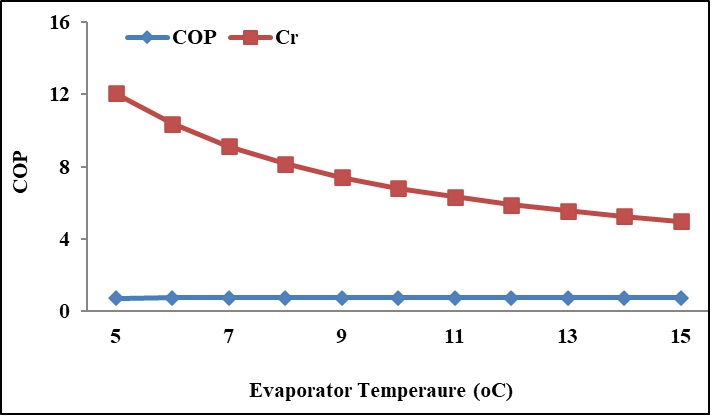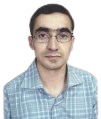Thermodynamic Analysis of Solar-based Combined Power and Cooling Cogeneration Cycle

DOI:
https://doi.org/10.54060/jmce.2023.49Keywords:
Heliostats, solar field, absorption refrigeration, evaporator, exergy destructionAbstract
The performance of a solar-powered Rankine cycle that combines absorption refrig-eration with solar thermal technology is examined in this communication. The re-search finds regions of irreversibility in the system and takes into account fluctuations in direct normal irradiance (DNI). In order to evaluate the cycle's performance at dif-ferent DNI levels ranging from 600 to 1050 W/m², the research does a thermody-namic analysis of the cycle. It also assessed the irreversibility of each cycle's distinct parts, which resulted in potential performance-enhancing actions. Furthermore, the central receiver contributes 31.37% irreversibility to the cycle's exergy distribution, the heliostat contributes 27.4%, and other components like the HRSG, steam turbine, and VARs contribute the rest amounts. Only 25.43% of the cycle's energy production is useable.
Downloads
References
Y. Lv, “Transitioning to sustainable energy: opportunities, challenges, and the potential of blockchain technology,” Frontiers in Energy Reserach, vol. 11, 1258044, 2023, 10.3389/fenrg.2023.1258044.
D. Gielen, F. Boshell, D. Saygin, M. D. Bazilian, N. Wagner, R. Gorini, “The role of renewable energy in the global en-ergy transformation,” Energy Strategy Reviews, vol. 24, pp. 38–50, 2019
A. Q. Al-Shetwi, “Sustainable development of renewable energy integrated power sector: Trends, environmental im-pacts, and recent challenges,” Science of the Total Environment, vol. 822, 153645, 2022.
G. Li, M. Li, R. Taylor, Y. Hao, G. Besagni, and C. N. Markides, “Solar energy utilisation: Current status and roll-out po-tential,” Applied Thermal Engineering, vol. 209: 118285, 2022.
S. Adibhatla, S. C. Kaushik, “Energy, exergy, economic and environmental (4E) analyses of a conceptual solar aided coal fired 500 MWe thermal power plant with thermal energy storage option,” Sustainable Energy Technologies and Assessments, vol. 21, pp. 89–99, 2017.
M. Kanoglu and I. Dincer, “Performance assessment of cogeneration plants,” Energy Conversion Management, vol. 50: pp. 76–81, 2009.
T. Ahamad, M. Parvez, S. Lal, O. Khan, M. J. Idrisi, “4 E analysis and multiple objective optimizations of a novel so-lar powered cogeneration energy system for the simultaneous production of electrical power and heating,” Scientific Report, vol. 13, 22246, 2023, https://doi.org/10.1038/s41598-023-49344-2.
M. Parvez, O. Khan, and H. Howari, “Investigation of energy, exergy, and environmental (3E) analysis of syngas pro-duction for combined power and cooling plant by testing different biomasses,” Biomass Conversion and Biorefinery, 2023; https://doi.org/10.1007/s13399-023-04746-0.
M. Rabbani, T. A. H. Ratlamwala, I. Dincer, “Development of a new heliostat field based integrated solar energy sys-tem for cogeneration,” Arabian Journal for Science and Engineering, vol. 43, pp. 1267–1277, 2018.
N. S. Ganesha, M. Omprakash, “Comprehensive review on cogeneration systems for low and medium temperature heat recoveries,” Energy Sources, Part A: Recovery, Utilization, and Environmental Effects, vol. 44, no. 3, pp. 6404–6432, 2022.
M. Parvez, F. Khalid, O. Khan, “Thermodynamic performance assessment of solar based combined power and absorp-tion refrigeration cycle,” International Journal of Exergy, vol. 31, no. 3, pp. 232-248, 2020.
H. A. Dhahad, M. Hussen, P. T. Nguyen, H. Ghaebi, M. A. Ashraf, “Thermodynamic and thermoeconomic analysis of innovative integration of Kalina and absorption refrigeration cycles for simultaneously cooling and power genera-tion,” Energy Conversion and Management, vol. 203, 112241, 2020.
S. A. Mousavi, M. Mehrpooya, M. Delpisheh, “Development and life cycle assessment of a novel solar-based cogen-eration configuration comprised of diffusion-absorption refrigeration and organic Rankine cycle in remote areas,” Process Safety and Environmental Protection, vol. 159, pp. 1019-1038, 2022.
X. Liu, M. Yu, Z. Liu, S. Yang, “Exergy analysis and advanced exergy analysis of a novel power/refrigeration cascade system for recovering low-grade waste heat at 90-150 °C,” ACS Sustainable Chemistry and Engineering, pp. 9184–9193, 2022.
S. Zhang, X. Hao, W. Yin, Q. Han, “Proposal and comprehensive analysis of a new high-efficiency combined cycle for simultaneous power generation, refrigeration, or heating to meet seasonal energy demand,” Energy Conversion and Management, vol. 301, 118036, 2024.
M. Parvez, M. E. Khan, F. Khalid, O. Khan, W. Akram, “A novel energy and exergy assessments of solar operated com-bined power and absorption refrigeration cogeneration cycle,’ Electric Vehicles, Green Energy and Technology, pp. 213-229, 2022, https://doi.org/10.1007/978-981-15-9251-5_13.

Downloads
Published
How to Cite
CITATION COUNT
Issue
Section
License
Copyright (c) 2023 Mohd Parvez, Samia Parvez, Osama Khan

This work is licensed under a Creative Commons Attribution 4.0 International License.
























